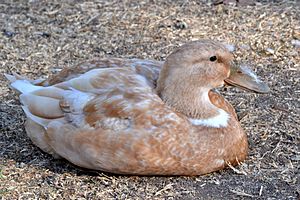Orpington Duck facts for kids

A female at Hahn Park, California
|
|
| Conservation status | RBST (UK): at risk |
|---|---|
| Country of origin | United Kingdom |
| Classification | |
| PCGB | light |
|
|
The Orpington Duck, also known as the Buff Orpington Duck, is a special type of domestic duck. These ducks are super useful because they are good for both meat and egg production. Imagine, one Orpington Duck can lay up to 220 eggs in a single year!
This amazing duck breed was first created by a man named William Cook. He lived in Orpington, Kent, in the United Kingdom. William Cook was also famous for developing the Orpington chicken. He carefully chose ducks with specific colors to create the Orpington Duck we know today.
Contents
The History of Orpington Ducks
William Cook developed the Orpington Duck by mixing several other duck breeds. Some of these included the Cayuga, Indian Runner, Aylesbury, and Rouen ducks. He wanted to create a duck with a popular "buff" (a yellowish-brown) color.
The Orpington Duck was first shown to the public in October 1897. This happened at a big event called the Dairy Show in London. In 1910, the breed was officially recognized in the British Poultry Standard. Later, in 1914, it was added to the American Poultry Association's Standard of Perfection as the 'Buff Duck'.
Orpington Duck Colors
Orpington Ducks come in a few different colors. The most common is Buff, but you can also find them in Blond and Brown.
The Buff color can be a bit tricky! This is because of a special gene that causes color changes. So, when two Buff Orpington Ducks have ducklings, you might see all three color variations (Buff, Blond, and Brown) in their offspring.
What Orpington Ducks Look Like
Orpington Ducks have a very distinct look. They have neat, oval-shaped heads and long necks. Their bodies are long, and they have deep chests, which makes them look quite grand. They also stand a little bit tall.
For show ducks, having a uniform color is very important. The ideal color is a fawn-buff. Male ducks, called drakes, often have a fawn-buff or even a seal-brown head. Drakes have a yellow bill, while the female ducks have a brownish-orange bill. All Orpington Ducks have bright orange feet and legs.
Conservation Status
Sadly, the Orpington Duck is considered a threatened breed. Organizations like the ALBC are working to protect them. In the UK, the RBST also lists them as "at risk." This means there aren't many of them left, and they need our help to survive!

